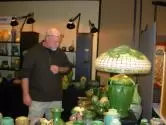Final Thoughts on an Arts and Crafts Conference

On Monday evening, March 23, 1903, a nervous, 45-year-old Gustav Stickley stood at the door to the Craftsman Building in downtown Syracuse, where he began greeting the nearly 200 influential people he had invited to the opening of his inaugural Arts & Crafts conference.
Stickley’s conference ran for a scheduled 14 days, during which time curious observers could stroll through the exhibitions, enjoy light refreshments, chat with Irene Sargent, the editor and chief writer of The Craftsman magazine, and meet Mr. Stickley. During the evenings a small orchestra played in the background as people made their way down the hallway to hear seminars on such topics as “The Arts and Crafts Movement: Its Origin and Relation to Modern Life.”
Sound familiar?
And this was 1903.
As expected, Stickley’s craftsmen had spared no expense or effort in preparing his personal display of Craftsman furniture for his audience. They created a model dining room, consisting of a director’s table and eight leather and brass-studded chairs, a massive sideboard with strap hinges, a corner server and a matching linen chest, all carefully arranged on a deep green Donegal rug. The table was set with champagne glasses and porcelain plates atop a yellow embroidered Craftsman table runner.
Citizens of Syracuse and the surrounding area were charged a twenty-five cent admission, about the equivalent of five dollars today, for the opportunity to both view and purchase items in the exhibition. A headline in a local paper proclaimed “Crowds Flock to Crafts Exhibition” and the reviewers were kind to this shocking new style of home furnishings, noting that “the Stickley furniture has made many converts” and that it was “beautiful in its simplicity, its finish and materials,” though one writer did comment that it looked “as substantial as a man of war.”
What was equally as important as the introduction of the Arts and Crafts style and this middle-aged furniture designer was a little-known sidebar that has often been overlooked.
Gustav Stickley did not simply exhibit his own Craftsman furniture in this 1903 public display. He invited other Arts and Crafts designers, some presumably his friends, to display their works as well. There in the Craftsman Building, had we been present in 1903, we could have taken our pick of a number of matte green vases designed by 36-year-old William Grueby, who undoubtedly rode the train over from Boston to support his friend, with whom he had shared a booth at a show in Buffalo two years earlier.
And that was not all.
There were hand-decorated bowls sent up from the Rookwood Pottery in Cincinnati; moss-draped vases picked out by the girls at Newcomb College and carefully crated in straw for the trip from New Orleans; carved porcelains brought over from the nearby studio of Adelaide Robineau; brass candlesticks sent from Chicago by Jessie Preston and Robert Jarvie; and rare sculpted vases by Artus Van Briggle in Colorado, who would die a few months later at the tender age of 35 from tuberculosis.
As I think about this list of designers — Stickley, Grueby, Rookwood, Newcomb, Robineau, Preston, Jarvie, Van Briggle — whose work was brought together for an Arts and Crafts conference in 1903, I cannot help but make comparisons. Last week in the Grand Ballroom at the Grove Park Inn, we, too, walked amid booths teeming with antique furniture, art pottery and metalware by these same now-famous designers.
We also strolled past booths staffed by designers not yet as well-known — Draves, Wilder, Glapa, Hicks, Zito, VanOstrand, Brown, Katrich, Clark, Witkowski, Accardi, Yoshiko, Bertucci, Lowery, Ayres, Pratt, Hause, Maynard, Miller and others.
And someday people will say in amazement, “Can you believe they were all there, in one exhibition, for one weekend? And that they all knew each other?”
Pretty amazing.

Until next Monday,
Have a great week!
Bruce
For more information on Gustav Stickley and his 1903 exhibition, please see David Cather’s seminal study simply entitled Gustav Stickley.
Top Photo: a recreation of Stickley’s 1903 exhibit assembled at the Dallas Museum of Art in 2011.
